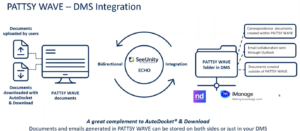Data is knowledge, and knowledge is power. Disorganized and inconsistent data across disparate systems, however, is a recipe for chaos and causes a continuous drain on productivity. The exponential surge in digital data volumes during the last few years has led to IP professionals putting a lot more effort into accessing, managing, and archiving information.
In the 2022 Wolters Kluwer Future Ready Lawyer Survey, 79% of IP professionals cited coping with the increased volume and complexity of the information as one of the top challenges (2022 Wolters Kluwer Future Ready Lawyer Survey Report p.3). Remote working further aggravates such data management challenges, especially when users must access siloed content from multiple IP software tools and Document Management Systems (DMS) to complete their work.
Rising to the challenge, firms are embracing cloud-based applications and integrating their applications and collaboration tools to keep team members, clients, and business partners connected and working efficiently. In this blog, we discuss how an integration using Connectivity (formerly SeeUnity)’s Echo Content Synchronization (Echo) between PATTSY WAVE® and your document management system helps streamline and automate workflow processes.
The Need for Integration Software
Because IP professionals often have to maneuver through multiple systems and applications, each with a distinct user interface, their work can feel disjointed. This process can also yield incomplete, duplicative, and inconsistent data. Collaboration gets hindered, and security and compliance issues arise. This becomes even more challenging with poor user experience due to administrative tasks increasing and redundant data-entry points. The result is diminished overall efficiency and increased process complexity.
Integration software helps the IP operations team address these challenges by simplifying their day-to-day processes with automated content synchronization. Further, the ease of utilizing best-of-breed applications while automatically keeping contents in sync with other mission-critical systems results in an elevated user experience.
By integrating IP management software such as PATTSY WAVE with your document management system, you can:
- Improve operational efficiency by reducing manual processes
- Simplify IP management software workflow with content access and automation
- Automate the flow of content to the record repository
DMS Integration with PATTSY WAVE: Behind the Scenes
The API-based Echo Solution securely synchronizes content and meta-data between PATTSY WAVE and any of your on-premise or cloud DMS or file-sharing systems. You can configure with one-way or two-way synchronization as per your workflow requirement. (Fig. 1) Sync rules, which run on a scheduled basis, can be set to run as often as once per minute. Echo supports DMS integration with NetDocuments, iManage, and other file-sharing systems.
Docketing teams can add or update content in either system, while the content automatically stays up to date and in sync across both applications. Users can conveniently access and edit documents and email correspondence in the DMS from within PATTSY WAVE with native DMS functionality and versioning.
IP operations teams that utilize the AutoDocket® & Download feature of PATTSY WAVE can significantly benefit from the DMS integration. Documents, correspondence, and client communications uploaded to PATTSY WAVE matters or the USPTO communications added via AutoDocket® & Download will automatically synchronize with your DMS.

Figure 1: PATTSY WAVE - DMS Integration
Leverage Process Automation Options
You can eliminate manual content transfer processes by utilizing Echo’s intelligent automation capabilities. Depending upon your workflow, you can configure Echo for various scenarios:
1. Automatically sync content to corresponding matters in your DMS
For existing and newly entered matters in PATTSY WAVE, Echo automatically detects the corresponding DMS workspaces and creates a PATTSY WAVE subfolder within each workspace. The documents added to the PATTSY WAVE matter will be synced to the new DMS subfolder, and the documents added to the DMS subfolder will be synced to the matter in PATTSY WAVE.
2. Documents can be either moved or copied from PATTSY WAVE to your DMS
Your team can choose to keep documents in both PATTSY WAVE and the DMS or only in the DMS. If the primary objective is to keep all correspondence in a single repository, then your team would likely choose to keep documents only in the DMS. However, if your team wants to make USPTO correspondence and other documents available for your clients, then they should be kept in PATTSY WAVE and also in your DMS.
In either scenario, the stub files, which are links to documents, would be kept within PATTSY WAVE. This will allow your internal team to access documents from PATTSY WAVE but open them in your DMS.
Content Governance and Reporting
Your IT department can maintain complete administrative oversight and control of sync rules using the Echo Management Studio. It retains all sync activity history. In addition, the Echo Management Studio provides auditing and reporting capabilities.
Moving Forward
The new document management system integrations for PATTSY WAVE using Connectivity’s Echo solution have opened opportunities for other valuable integrations to help IP professionals save time and improve productivity. Stay tuned for future integrations with matter management systems, accounting, finance, and HR systems in upcoming releases.
Interested to see Connectivity’s Echo integration capabilities with PATTSY WAVE in action?
You can schedule a demo here.




